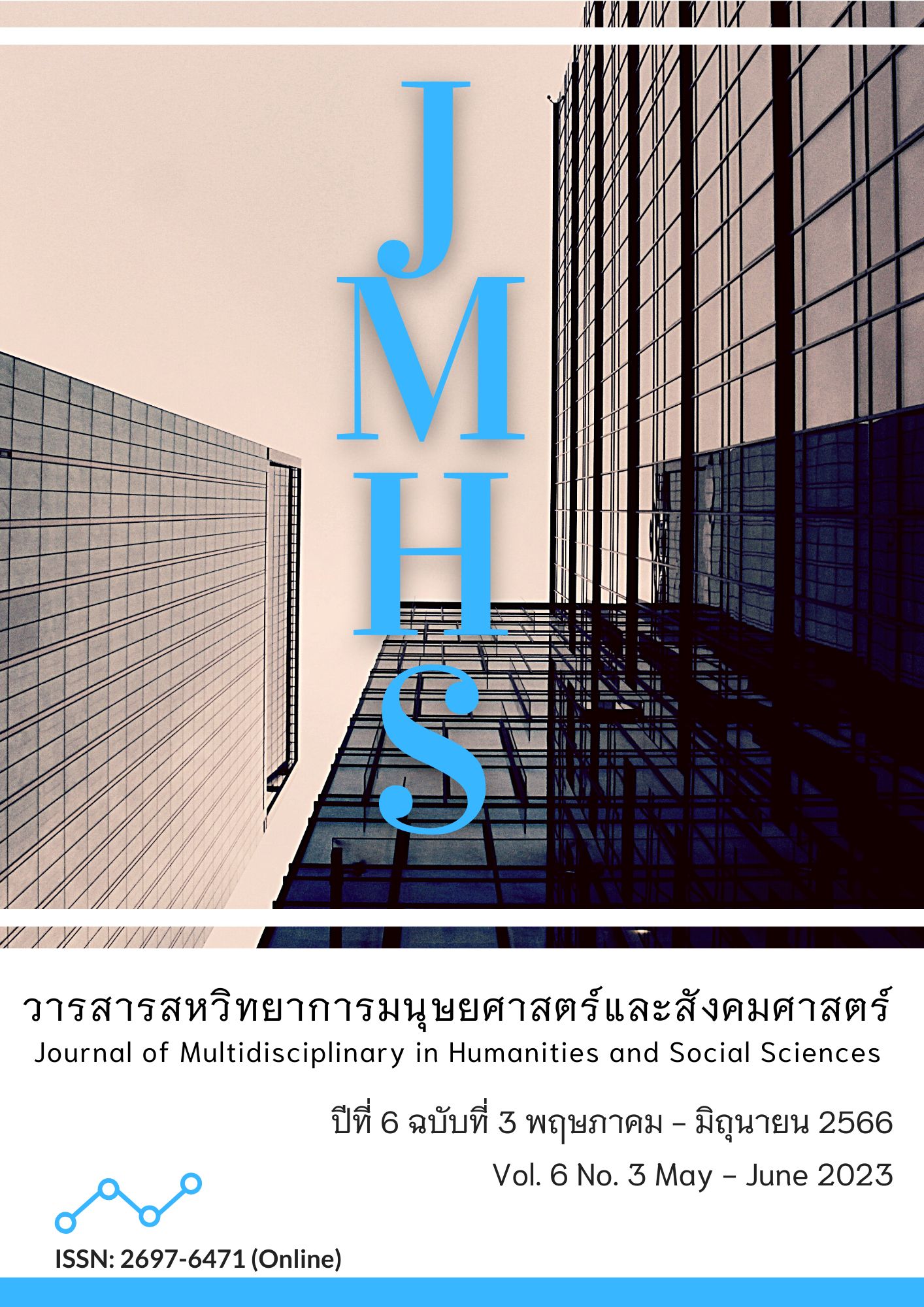Products Price Management of Business Entrepreneur After the Covid-19 Era
Main Article Content
Abstract
This article aimed to explain the conceptualization of product price management in relation to key factors after the COVID-19 era of business entrepreneurs, when the business shop to start a business by remodeling creates more special products at higher prices or according to cost. Some businesses whose prices do not match the cost of the product follow the high image investment and create an emotion to show high value. Therefore, the price must be set as high as the desired target to achieve a quick cashback or a large profit. In this regard, consumers decide on expenses that are suitable for income from the post-COVID economic situation in Thailand. When the country opens, entrepreneurs hope that tourists will spend money to buy products like in the past, but they may be disappointed because the world was affected by the economic contraction or slump. Therefore, the product price management of entrepreneurs should consider cost as an especially important factor in organizational goals, and after COVID-19, the focus should be on the need for learning about tourism, purchasing systems, marketing, and technology that create a balance in value satisfied under the virtue of sharing for society and the environment.
Article Details

This work is licensed under a Creative Commons Attribution-NonCommercial-NoDerivatives 4.0 International License.
Views and opinions appearing in the Journal it is the responsibility of the author of the article, and does not constitute the view and responsibility of the editorial team.
References
กานต์มณี การินทร์, ฐิติพร วรฤทธิ์, แก้วมณี อุทิรัมย์, กนกเกล้า แกล้วกล้า และ ภัคณิษา อภิศุภกรกุล. (2566). ปัจจัยที่มีอิทธิพลต่อการมีส่วนร่วมในการสร้างอาชีพเสริมในช่วงสถานการณ์การแพร่ระบาดของโรคติดเชื้อไวรัสโคโรนา 2019. วารสารนวัตกรรมการจัดการศึกษาและการวิจัย, 5(1), 25-36. สืบค้นจาก https://so02.tci-thaijo.org/index.php/jemri/article/view/257778
ประชาชาติธุรกิจออนไลน์. (2561, 7 มกราคม). น้ำมันพรีเมี่ยม คุ้มจริงหรือ. สืบค้นเมื่อ 17 เมษายน 2564, จาก https://www.prachachat.net/economy/news-97330#google_vignette
ประชาไท. (2565, 10 มิถุนายน). ไทยกู้เงินรัฐบาลญี่ปุ่น 1.3 หมื่นล้าน อายุ 15 ปี แก้ไขวิกฤตโควิด-19. สืบค้นเมื่อ 5 มีนาคม 2566, จาก https://prachatai.com/journal/2022/06/99014
ปรีชา สุดใจ และ ทิพย์ลาวัลย์ แก้วนิล. (2566). ความสัมพันธ์ระหว่างกลยุทธ์การบริการและความได้เปรียบทางการแข่งขันของผู้ประกอบการในจังหวัดนครปฐม. วารสารนวัตกรรมการจัดการศึกษาและการวิจัย, 5(1), 73-84. สืบค้นจาก https://so02.tci-thaijo.org/index.php/jemri/article/view/258479
พิชามญชุ์ เลิศวัฒนพรชัย, พงษ์สันติ์ ตันหยง และ ผ่องใส สินธุสกุล. (2566). ปัจจัยที่มีอิทธิพลต่อการตัดสินใจใช้บริการสั่งอาหารแบบเดลิเวอรี่ผ่านสื่อเล็กทรอนิกส์ในจังหวัดนครปฐม. วารสารสหวิทยาการมนุษยศาสตร์และสังคมศาสตร์, 6(1), 151-154. สืบค้นจาก https://so04.tci-thaijo.org/index.php/jmhs1_s/article/view/261641/178306
แพตทริก บาร์ไวส์. (2563). คัมภีร์การตลาด (ฉบับปรับปรุง). ปฏิพล ตั้งจักรวรานนท์. (ผู้แปล). กรุงเทพฯ: เอ็กซเปอร์เน็ท.
พระพรหมคุณาภรณ์ (ป.อ. ปยุตโต). (2551). พุทธธรรม. กรุงเทพฯ: สหธรรมิก.
สุณัฐวีย์ น้อยโสภา. (2561). ความแตกต่างทางวัฒนธรรมปัจจัยสำคัญในการขยายธุรกิจสู่ตลาดโลก.วารสารวิชาการมหาวิทยาลัยธนบรี, 12(27), 187-194. สืบค้นจาก https://so03.tci-thaijo.org/index.php/trujournal/article/view/110432
สำนักข่าวกรมประชาสัมพันธ์. (2566, 26 มกราคม). เราเที่ยวด้วยกัน เฟส 5 ช่วยลดค่าที่พัก กระตุ้นเศรษฐกิจภาคการท่องเที่ยวกว่า 3,000 บาทต่อสิทธิเริ่มกุมภาพันธ์นี้. สืบค้นเมื่อ 6 มีนาคม 2566, จาก https://thainews.prd.go.th/th/news/detail/TCATG230126095457641
สำนักข่าวกรมประชาสัมพันธ์. (2564, 6 พฤษภาคม). 4 มาตรการกระตุ้นเศรษฐกิจหลังสถานการณ์การแพร่ระบาดของโรคโควิด-19 คลี่คลาย ครอบคลุมประชาชนกว่า 51 ล้านคน. สืบค้นเมื่อ 6 มีนาคม 2566, จาก https://thainews.prd.go.th/th/news/detail/TCATG210506202123014
สิริโฉม พรหมโฉม. (2562). การกำหนดราคาสินค้าหรือบริการควบคุมตามพระราชบัญญัติว่าด้วยราคาสินค้าและบริการ พ.ศ. 2542. วารสารจุลนิติ, 11(2), 169. สืบค้นจาก https://www.senate.go.th/assets/portals/93/fileups/272/files/S%E0%B9%88ub_Jun/12know/k145.pdf
สรา ชื่นโชคสันต์, ภาวนิศร์ ชัววัลลี และ วิริยะ ดำรงค์ศิริ. (2562). 8 ข้อเท็จจริง ปัญหาการเงินของครัวเรือนไทย. สืบค้นเมื่อ 5 มีนาคม 2566, จาก https://www.bot.or.th/Thai/ResearchAndPublications/DocLib_/Article_30Oct2019.pdf
เสาวณี จันทะพงษ์ และ ทศพล ต้องทุ้ย. (2563). เศรษฐกิจโลก เศรษฐกิจไทยหลังโควิด-19: โรคปฏิวัติโลก ยกเครื่องสู่อนาคตวิถีชีวิตใหม่. BOT พระสยาม MAGAZINE, 3(3), 4-7. สืบค้นจาก https://www.bot.or.th/broadcast/BOTMagazine/2563/BOT3_63/mobile/index.html#p=1
อิชิฮาระ อากิระ. (2563). ขายดีเพราะขึ้นราคา. กรุงเทพฯ: วีเลิร์น.
thematter.co. (2560, 5 เมษายน). มีเงินก็ซื้อไม่ได้’ ความซับซ้อนของรสนิยมจากมิติสังคมวิทยา. สืบค้นเมื่อ 17 เมษายน 2564, จาก https://thematter.co/social/taste-cannot-be-taught-and-its-complexity/21552
Happy 8 Workplace. (2566, 27 มกราคม). 5 สไตล์การท่องเที่ยวที่เปลี่ยนไปหลังโควิด. สืบค้นเมื่อ 25 เมษายน 2566, จาก https://happy8workplace.thaihealth.or.th/articles/90
Bayat, M., Afshari, Z., & Tavakolian, H. (2016). Monetary policy and stock price index (On the basis of the wealth effect of the stock market boom) in a DSGE framework. Quarterly Journal of Applied Economics Studies in Iran, 5(20), 33 -61.
Docters, R., Katz, R., Bernstein, J., & Schefers, B. (2010). Is the Price Right? Strategies for New Introductions. Journal of Business Strategy, 31(3), 29–37. https://doi.org/10.1108/027566610110 36682
Dutta, S., Bergen, M., Levy, D., Ritson, M., & Zbaracki, M. (2002). Pricing as a strategic capability. MIT Sloan Management Review, 43 (3), 61–66.
Guerello, C. (2016). The Effect of Investors’ Confidence on Monetary Policy Transmission Mechanism: A Multivariate GARCH Approach. The North American Journal of Economics and Finance, 37, 248-266. https://doi.org/10.1016/j.najef.2016.05.003
Ingenbleek, P. (2007). Value-Informed Pricing in Its Organizational Context: Literature Review, Conceptual Framework, and Directions for Future Research. Journal of Product & Brand Management, 16(7), 441–458.
Lee, S. H., Deale, C. S., & Lee, J. (2022). Does it Pay to Book Direct?: Customers’ Perceptions of Online Channel Distributors, Price, and Loyalty Membership on Brand Dimensions. Journal of Revenue and Pricing Management, 21, 657–667. https://doi.org/10.1057/s41272-022-00382-x
Liozu, S. M., Feurer, S., Hinterhuber, A., & Woodside, A. (2021). Configurational Theory and Practices of Firms Employing Multiple Pricing Policies: Assessing Effective and Ineffective Pricing Recipes in Multiple Firm Contexts. Journal of Revenue and Pricing Management, 20, 420–435. https://doi.org/10.1057/s41272-021-00306-1
Miller, D. (1987). Strategy Making and Structure: Analysis and Implications for Performance. Academy of Management Journal, 30(1), 7–32.
Rahimian, F., Renani, H. S., & Ghobadi, S. (2022). The Impact of Exchange Rate and Investor Confidence Uncertainty on Monetary and Economic Uncertainty in Iran. Journal of Money and Economy, 17(1), 115-136.
Taghinezhadomran, V., & Hajibabaei, V. (2014). The Effect of the Real Exchange Rate Changes on the Financial Instability in Selected Developing Countries. Quarterly Journal of Fiscal and Economic Policies, 2(5), 121-134.
Zohor, A. K., Ebad, E., & Rashid, N. (2021). A Study on the Contribution of Foreign Direct Investment to Economic Growth in Afghanistan. Journal of Money and Economy, 16(4), 555-568.


